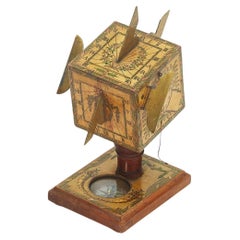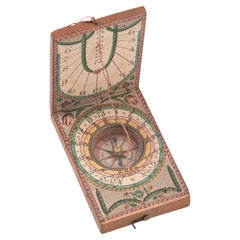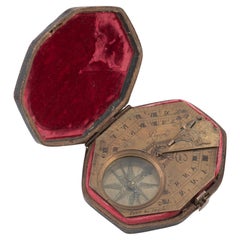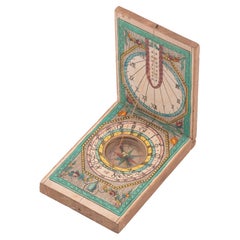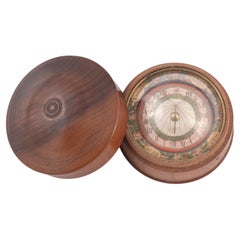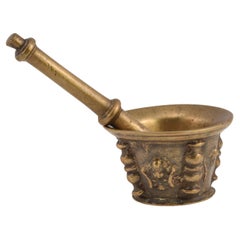Scientific Instruments
Late 18th Century German Neoclassical Antique Scientific Instruments
Wood
Late 18th Century German Neoclassical Antique Scientific Instruments
Paper
1790s French Neoclassical Antique Scientific Instruments
Brass
1810s German Neoclassical Antique Scientific Instruments
Paper
Early 19th Century German Neoclassical Antique Scientific Instruments
Wood
17th Century Spanish Baroque Antique Scientific Instruments
Bronze
20th Century American Classical Scientific Instruments
Brass
20th Century Unknown Neoclassical Scientific Instruments
Marble, Bronze, Brass
1730s Swedish Baroque Antique Scientific Instruments
Iron
19th Century French Neoclassical Antique Scientific Instruments
Porcelain
Late 19th Century French Neoclassical Antique Scientific Instruments
Brass
18th Century European Neoclassical Antique Scientific Instruments
Bronze
20th Century Italian Baroque Scientific Instruments
Metal
19th Century Irish Baroque Antique Scientific Instruments
Giltwood
18th Century Italian Baroque Antique Scientific Instruments
Bronze
Early 17th Century German Baroque Antique Scientific Instruments
Wrought Iron
17th Century Spanish Baroque Antique Scientific Instruments
Bronze, Other
18th Century French Neoclassical Antique Scientific Instruments
Bronze, Other
Early 18th Century French Neoclassical Antique Scientific Instruments
Metal, Bronze, Other
Late 18th Century German Neoclassical Antique Scientific Instruments
Bronze, Other
1730s Austrian Baroque Antique Scientific Instruments
Brass
19th Century German Baroque Antique Scientific Instruments
Wood
Mid-20th Century American Classical Scientific Instruments
Brass
Mid-19th Century British Baroque Antique Scientific Instruments
Crystal, Sterling Silver
1850s Austrian Baroque Antique Scientific Instruments
Steel
18th Century Italian Baroque Antique Scientific Instruments
Bronze
1840s Spanish Neoclassical Antique Scientific Instruments
Bronze
17th Century British Baroque Antique Scientific Instruments
Brass
Late 19th Century French Baroque Antique Scientific Instruments
Wood
Late 19th Century French Baroque Antique Scientific Instruments
Wood
19th Century European Neoclassical Antique Scientific Instruments
Copper, Iron
19th Century French Neoclassical Antique Scientific Instruments
Bronze, Enamel, Ormolu
1830s Italian Neoclassical Antique Scientific Instruments
Bronze
Early 17th Century French Baroque Antique Scientific Instruments
Bronze
20th Century Italian Neoclassical Scientific Instruments
Giltwood
Vintage, New and Antique Scientific Instruments
Decorating with vintage, new and antique scientific instruments, as well as other authentic collectibles and curiosities that can be found on 1stDibs, presents an opportunity to create a unique, natural history museum-like atmosphere in your home that can provoke conversation as often as it pays tribute to how far we’ve come in understanding our world.
The Age of Discovery (or the Age of Exploration) refers to a period during the 15th to 18th centuries that saw Europeans taking to the high seas to explore, trade and conquer various regions of the world. What we know about geography, the advancement of sea vessels and the development of scientific instruments all broadened significantly during this time.
With every new finding about our world, scientists invented tools to measure and record. While many of these objects are now obsolete, they are essentially works of art and have a rich history. Scientific instruments of a bygone era represent how far science and technology have advanced.
If you’re interested in introducing antique scientific instruments and tools to your decor to add contrast or draw attention to otherwise unexplored corners of your living room or dining room, there are many options to consider as far as textures and colors go. Like any curious decorative object that draws attention to your home library or mantel, vintage scientific instruments will likely add spirit to any conversation that might take place over cocktails or dinner.
Create an intriguing focal point with Georgian scientific instruments, such as stick barometers with mahogany cases or lacquered brass telescopes. These items stem from an era named for the monarchies of the four King Georges, who ruled England in succession starting in 1714 (plus King William’s reign, which lasted until 1837). Just as there was beautiful jewelry produced during the period that today is coveted by collectors, there is much to be found in the collectibles and curiosities realm too.
Mid-century modern scientific instruments also capture a period of rapid progress, representing groundbreaking discoveries that defined the 20th century. Wouldn’t antique anatomical models of the 1950s pair well with your eye-catching abstract paintings, George Nelson clock or Florence Knoll sofa?
Whether you’re looking for a way to showcase your passion for chemistry or aviation or are making room in your foyer for a breathtaking industrial-style electronic time tower manufactured by Patek Philippe, 1stDibs offers a collection of vintage, new and antique scientific instruments that includes topographic tools, laboratory equipment and more.
